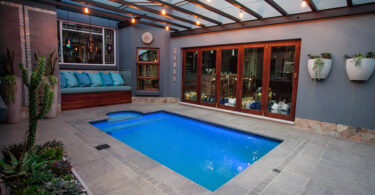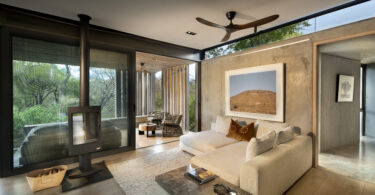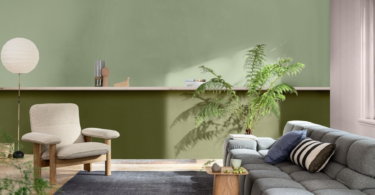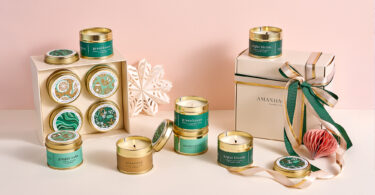By Annette Klinger, Photography Micky Hoyle, Production Liezel Norval-Kruger
In this colourful lounge, a cross-stitch motif is simplified to create a contemporary, pixelated feature.
You need
- Plascon Cashmere Dusk of Day (B6-E1-2)
- Plascon Cashmere Fuscia Fizz (R2-A1-1)
- Plascon Cashmere Golden Daffodil (Y3-A1-1)
- Plascon Cashmere Providence (B5-C1-3)
- Photocopier
- Transparency
- Transparency pen
- Polycell Sugar Soap
- Polyfilla Interior
- Sandpaper
- Drop sheet
- Masking tape
- Hamilton’s polypile roller
- Hamilton’s paintbrush
- Overhead projector
- Water-based pencil or chalk
- Hamilton’s artist brush
Get the décor effect
- Photocopy a cross-stitching pattern and trace onto transparency. Simplify the cross-stitch x’s into squares, and use a ruler when tracing to keep the squares straight.
- Wash the wall with sugar soap, fill holes with Polyfilla and allow to dry before sanding smooth.
- Lay a drop sheet and mask off the skirting board. Next, apply two layers of Plascon Cashmere Dusk of Day, allowing enough drying time between coats.
- Project the cross-stitch design onto the wall in the required size. Trace the outlines with a water-based pencil or chalk.
- Use tape to mask around each square before applying two coats of paint with the Hamilton’s artist brush, allowing drying time between coats. Where squares of different colours meet, ensure that one square is fully dry before masking and painting the adjacent one. We used the pink Plascon Cashmere Fuscia Fizz, the yellow Golden Daffodil and the blue Providence.
Style tips
- Simplify: Stylist Liezel Norval-Kruger suggests simplifying the design of a cross-stitch pattern by turning the x’s into solid squares, thus creating a pixelated effect.
- Tri-tone: Forego cross-stitch patterns that are too intricate. Opt instead for simple designs featuring no more than three colours.
- Scale up: Create maximum visual impact by exaggerating the scale of the original design.
- Accessorise: Pick accessories in colours that complement those of the design – in this case, a limited palette of bright, contrasting tones. Create visual interest by juxtaposing different textures and incorporating playful elements.












Leave a Comment